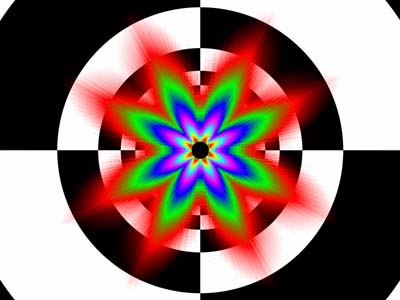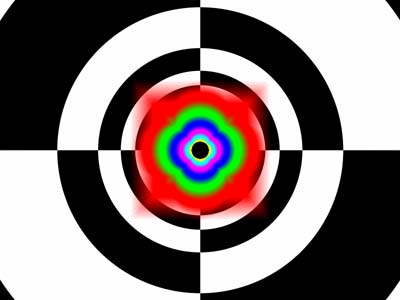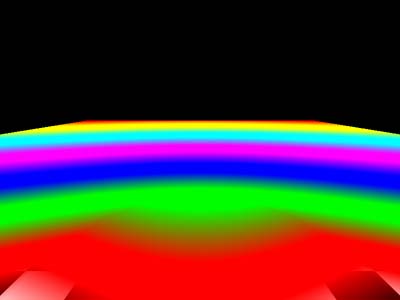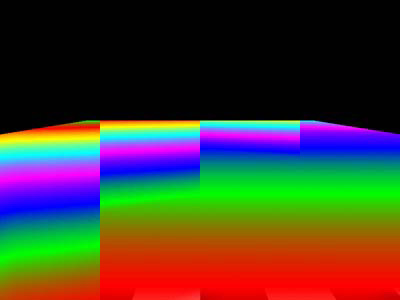Image Quality Analysis Fall 2003: A Glance Through the Looking Glass
by Derek Wilson on December 10, 2003 11:14 PM EST- Posted in
- GPUs
D3D AF Tester
For these tests, we used the D3D AF Tester that can be found at 3dcenter. Our tunnel test was taken by turning up the anisotropic filtering level to 8x and using full-colored mipmaps (all other settings were default). The plane tests were done using a distance of 15 and an angle of 75 degrees at each level of anisotropy and stage tested.  |
| ATI Tunnel 8x Anisotropic Filtering (Click to enlarge.) |
 |
| NVIDIA Tunnel 8x Anisotropic Filtering (Click to enlarge.) |
We can see the affect of ATI's weighted Manhattan distance calculation on the tunnel test. The LOD calculation is heavily dependent on x and y positions. This really gives us a good idea of just how different NVIDIA and ATI GPUs render textures. The resolution of the texture used varies a great deal with respect to the angle of the surface being textured. This means that just by rotating something around, the quality of the filtering being used is compromised (a smaller resolution texture than needed will be used). As there is a lot of interpolation going on here and horizontal and vertical surfaces are very common, the effects aren't particularly noticeable in game play. Of course, this helps to explain why in some screenshots, NVIDIA's textures look sharper than ATI's, while in others, ATI's textures look sharper than NVIDIA's.

ATI filtering differences (hold your mouse over the image for Control Panel Stage 1)

NVIDIA filtering differences (hold your mouse over the image for Control Panel Stage 1)
Here, we are looking at the differences in AF set by the control panel at stage 1 (we don't start with the highest resolution mipmap) and application controlled filtering at stage 0. With ATI, we can see that the card doesn't do either anisotropic or trilinear filtering when looking at any texture stage other than 0. We haven't been able to verify the exact impact of this optimization in a game, so we aren't really able to comment on the real world image quality implications of this.

From left to right: trilinear, 2xAF, 4xAF, 8xAF filtering (hold your mouse over the image for NVIDIA results)
We can see the differences between trilinear and the different levels of anisotropic filtering on the plane test. Anisotropic filtering is able to use higher resolution textures better at greater distances when the texture is at an angle to the viewer. Also, the differences between levels (2x, 4x, and 8x) of anisotropic filtering can be seen. Enabling a higher level of anisotropic filtering extends the distance from the viewer at which anisotroic filtering stops and trilinear filtering starts.
From these pictures, it is also evident that NVIDIA does more bilinear filtering when texels are near screen pixel sizes. This has been dubbed “brilinear” filtering by some, as the method blends bilinear filtering more heavily than usual into higher order filtering techniques. We have yet to see any perceptible image quality issues arise from this, and as long as banding is not evident and the highest possible resolution textures are used, this filtering method serves its purpose. NVIDIA assures us that if we can point out a loss in image quality in any game, they will correct it.










35 Comments
View All Comments
nourdmrolNMT1 - Thursday, December 11, 2003 - link
i hate flame wars but, blackshrike....there is hardly any difference between the images. and nvidia used to be way behind in that area. so they have caught up, and are actually in some instances doing more work to get the image to look a little different, or maybe they render everything that should be there, while ati doesnt (halo 2)
MIKE
Icewind - Thursday, December 11, 2003 - link
I have no idea what your bitching about Blackshrike, the UT2k3 pics look exactly the same to me.Perhaps you should go work for for AT and run benchmarks how you want them done instead of whining like a damn 5 year old..sheesh.
Shinei - Thursday, December 11, 2003 - link
Maybe I'm going blind at only 17, but I couldn't tell a difference between nVidia's and ATI's AF, and I even had a hard time seeing the effects of the AA. I agree with AT's conclusion, it's very hard to tell which one is better, and it's especially hard to tell the difference when you're in the middle of a firefight; yes, it's nice to have 16xAF and 6xAA, but is it NECESSARY if it looks pretty at 3 frames per second? I'm thinking "No"; performance > quality, that's why quality is called a LUXURY and not a requirement.Now I imagine that since I didn't hop up and down and screech "omg nvidia is cheeting ATI owns nvidia" like a howler monkey on LSD, I'll be called an nVidia fanboy and/or told that A) I'm blind, B) my monitor sucks, C) I'm color blind, and D) my head is up my biased ass. Did I meet all the basic insults from ATI fanboys, or are there some creative souls out there who can top that comprehensive list? ;)
nastyemu25 - Thursday, December 11, 2003 - link
cheer up emo kidBlackShrike - Thursday, December 11, 2003 - link
For my first line I forget to say blurry textures on the nvidia card. Sry, I was frustrated at the article.BlackShrike - Thursday, December 11, 2003 - link
Argh, this article concluded suddenly and without concluding anything. Not to mention, I saw definite blurry textures in UT 2003, and TRAOD. Not to mention the use of D3D AF Tester seemed to imply a major problem with one or the other hardware but they didn't use it at different levels of AF. I mean I only use 4-8 AF, I'd like to see the difference.AND ANOTHER THING. OKAY THE TWO ARE ABOUT THE SAME IN AF BUT IN AA ATI USUALLY WINS. SO, IF YOU CAN'T CONCLUDE ANYTHING, GIVE US A PERFORMACE CONCLUSION, like which runs better with AA or AF? Which creates the best with both settings enabled?
Oh and AT. Remember back to the very first ATI 9700 Pro, you did tests with 6x AA and 16 AF. DO IT AGAIN. I want to see which is faster and better quality when their settings are absoulutely maxed out. Because I prefer playing 1024*768 at 6x AA and 16 AF then 1600*1200 at 4x AA 8x AF because I have a small moniter.
I am VERY disappointed in this article. You say Nvidia has cleaned up their act, but you don't prove anything conclusive as to why. You say they are similar but don't say why. The D3D AF Tester was totally different for the different levels. WHAT DOES THIS MEAN? Come on Anand clean up this article, it's very poorly designed and concluded and is not at all like your other GPU articles.
retrospooty - Thursday, December 11, 2003 - link
Well a Sony G500 is pretty good in my book =)Hanners - Thursday, December 11, 2003 - link
Not a bad article per se - Shame about the mistakes in the filtering section and the massive jumping to conclusions regarding Halo.gordon151 - Thursday, December 11, 2003 - link
I'm with #6 and the sucky monitor theory :P.Icewind - Thursday, December 11, 2003 - link
Or your monitor sucks #5ATI wins either way